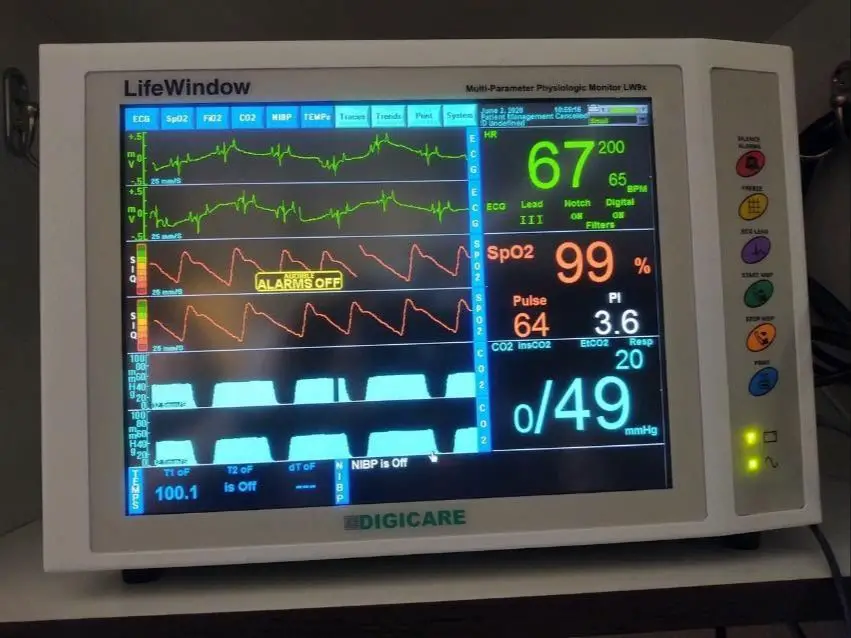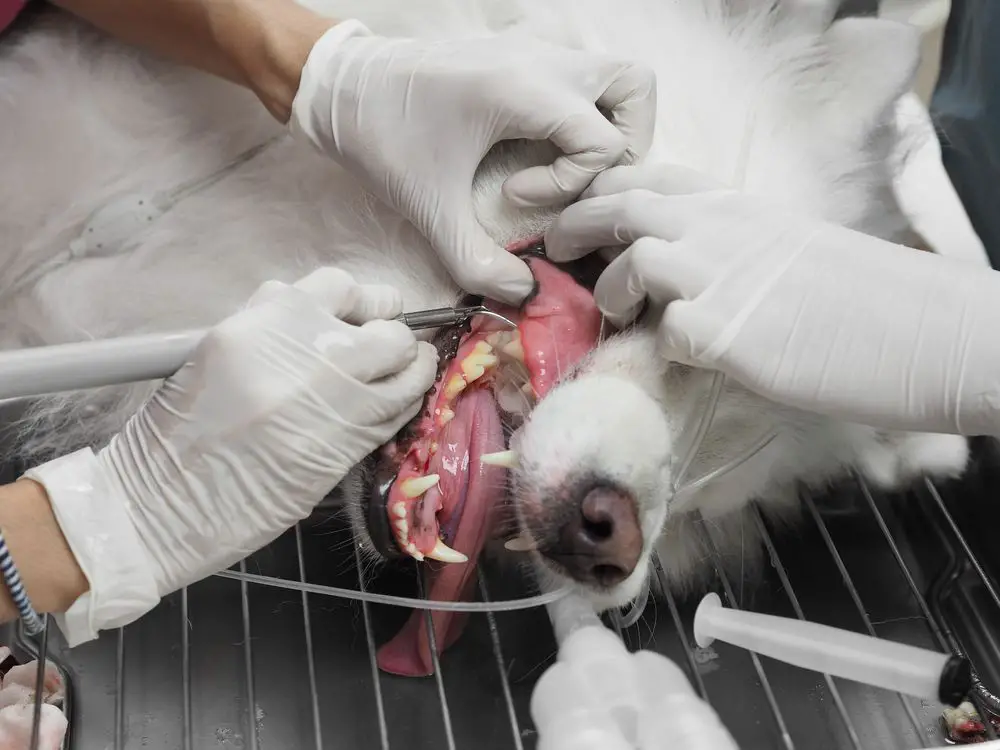Introduction
Dental cleanings are an important preventative healthcare procedure for dogs to maintain good oral health and hygiene. During a dental cleaning, the veterinarian will scale the dog’s teeth above and below the gumline to remove tartar, plaque, and bacteria that can cause tooth decay, gum disease, and bad breath. Anesthesia is used during dental cleanings for several reasons:
- To keep the dog still and relaxed during the procedure. Cleaning a dog’s teeth thoroughly requires the dog to be completely immobile, which is unlikely without anesthesia.
- To prevent pain or discomfort. Scraping tartar from a dog’s teeth can cause pain and sensitivity. Anesthesia keeps the dog comfortable and pain-free.
- For safety. An anesthetized dog is less likely to bite or resist, allowing the veterinarian to safely clean the teeth and inspect the entire mouth.
While dental cleanings require general anesthesia, the benefits far outweigh the small risks involved. Proper dental care can help dogs live longer, healthier lives by preventing dental disease that could lead to bacteria spreading throughout the body.
Pre-Anesthetic Evaluation
Dogs undergoing anesthesia will have a pre-anesthetic evaluation to assess any potential health risks. This involves bloodwork, a physical exam, and reviewing the dog’s medical history. The vet will evaluate things like:

– Organ function – Bloodwork helps check kidney and liver function to ensure the dog can properly metabolize anesthesia.
– Anemia – Anemia could mean greater risk of low oxygen levels under anesthesia.
– Electrolyte imbalances – These can lead to abnormal heart rhythms.
– Pre-existing conditions – Diseases like heart disease, respiratory disease, or seizure disorders can pose added risks.
– Age – Older dogs may be at higher anesthesia risk.
– Medications – Some medications can interact with anesthesia drugs.
The vet uses all this information to determine if the dog is healthy enough for anesthesia or if any special precautions are needed to reduce risks. Addressing any concerns beforehand helps lead to safer anesthesia.
Anesthesia Administration
The vet will administer anesthesia through an intravenous (IV) catheter or breathing mask. Small dogs usually receive injectable anesthesia through the IV catheter. This allows precise dosing and the effects begin working quickly. Larger dogs are more likely to receive gas anesthesia through a mask. They start inhaling an anesthetic gas mixture which provides continuous sedation throughout the procedure.
The vet monitors the dog closely to ensure they receive enough anesthesia to stay sedated, but not too much to endanger their health. The anesthetic dose may be adjusted up or down as needed. Intravenous anesthesia generally lasts about 45-90 minutes from administration to full recovery. Inhaled gas anesthesia may have a shorter or longer duration, depending on the specific protocol. The vet determines the appropriate anesthetic agents and dosing based on the dog’s health status and dental needs.
Anesthesia Duration
The length of time a dog is under anesthesia for a dental cleaning can vary quite a bit depending on the specific procedure being performed and the health status of the dog. However, on average, most routine dental cleanings take 1-2 hours from the time anesthesia is administered until the dog wakes up.
Here is a rough timeline for anesthesia duration for a routine teeth cleaning:

- 5-15 minutes for pre-medication and induction of anesthesia
- 30-90 minutes for the actual cleaning procedure
- 15-30 minutes for monitoring during the wake up process
So in total, a typical dental cleaning and anesthesia takes about 60-120 minutes from start to finish. Puppies and smaller dogs may be under anesthesia for closer to 60 minutes, while larger dogs and dogs receiving more extensive dental work may be under for closer to 2 hours.
The veterinarian will monitor the dog closely throughout the procedure and adjust anesthesia as needed. Their primary focus is keeping the dog safe and stable while performing the necessary dental work.
Cleaning Procedure
The teeth cleaning procedure typically involves the following steps:
Pre-cleaning exam – The veterinarian will perform an oral exam to check for any concerning signs of disease and to determine the full extent of tartar buildup and plaque.
Anesthesia – As mentioned, the dog is put under general anesthesia for the duration of the cleaning procedure for safety and comfort.
Tartar removal – Using ultrasonic scaling equipment and hand instruments, the vet will thoroughly remove all built-up tartar above and below the gumline. This gets rid of tartar and also smooths the tooth surface.
Polishing – After debridement, the teeth are polished using a polishing paste and specialized cup to remove any remaining plaque and provide a smooth, clean tooth surface.
Flushing – Antimicrobial rinses may be used to flush beneath the gumline to remove bacteria and reduce infection risk.
Other – Additional steps like fluoride treatments may also be done to protect tooth enamel.
Exam – Once the cleaning is complete, the vet performs another oral exam to ensure the teeth and gums are healthy before recovery.
Monitoring the Anesthetized Patient
It is crucial to carefully monitor an anesthetized patient throughout the dental procedure. The veterinary team will closely watch the dog’s vital signs, including:
- Heart rate and rhythm
- Respiratory rate and pattern
- Blood pressure
- Oxygen levels
- Body temperature
- Reflexes
- Mucous membrane color

The anesthesia equipment provides real-time data on oxygen and carbon dioxide levels, EKG, heart rate, respiration, and blood pressure. The veterinary team continually assesses anesthesia depth based on vital parameters and makes adjustments as needed. They can increase anesthesia if the heart rate or blood pressure rises, indicating light anesthesia depth. If vital signs drop too low, anesthesia can be lightened. The goal is to maintain safe, stable anesthesia levels throughout the dental procedure.
Additionally, the team monitors the dog’s eyes for signs of corneal drying and lubricates them as needed. They also monitor body temperature and provide warming support like heated blankets if needed.
Recovery Process
After the dental cleaning is complete, your dog will be taken off the anesthetic gas and oxygen mix and placed in a recovery area. Dogs need to be closely monitored as they wake up from anesthesia because it is common for them to be disoriented, nauseous, or uncoordinated.
The vet or veterinary technician will monitor your dog’s vital signs like heart rate, respiration, and oxygen levels. They will also monitor reflexes and reactions. Your dog may receive some medication intravenously to help manage any nausea or discomfort.
Your dog will be kept in a quiet, darkened recovery area until the effects of anesthesia have mostly worn off. This usually takes 1-2 hours. Your vet may administer IV fluids during this time to help clear the anesthetic from your dog’s system. Soft bedding and blankets are provided to keep your dog comfortable as they recover.
Once your dog is alert and able to walk, the vet will go over discharge instructions with you. Your dog should not be left alone for the next 12-24 hours since the anesthetic effects can last this long. Appetite and energy levels may be decreased for 24-48 hours after anesthesia.
Going Home
After your dog wakes up from the anesthesia and is stable, the veterinarian will go over discharge instructions before allowing you to take your dog home. These instructions are important for monitoring your dog’s recovery and making sure there are no post-operative complications.
The veterinary staff will inform you of your dog’s vital signs like temperature, pulse, and respiration rate that you should monitor periodically at home. They will also advise you on the dog’s activity level – for example, your dog should only go on short leash walks for the first 24 hours. Jumping, running, and playing should be avoided during the initial recovery period.

You will also receive instructions on administering any take-home medications. This usually includes pain medication like non-steroidal anti-inflammatory drugs. It’s important to carefully follow the dosage directions and not miss any doses, as this helps manage pain and prevent complications. Any other drugs like antibiotics may also be prescribed.
In addition, you should watch for signs of bleeding from the mouth, difficulty eating or swallowing, vomiting, diarrhea, lethargy or restlessness. The veterinary team will tell you when to bring your dog back for a follow up exam to check healing. Most importantly, you need to carefully follow all take-home instructions to ensure your dog has a smooth recovery after a dental cleaning procedure under anesthesia.
Anesthesia Risks
There are always some risks associated with putting a dog under anesthesia. However, veterinarians take steps to minimize these risks through proper patient screening, monitoring, and care.
Some potential anesthesia risks include:
- Breathing problems – The anesthesia can sometimes depress respiratory function. The vet monitors breathing closely and can adjust oxygen levels as needed.
- Low blood pressure – Anesthesia can lower blood pressure. Fluid therapy helps maintain normal blood pressure.
- Hypothermia – Anesthesia makes it harder for the body to regulate temperature. The vet uses heated tables and warm IV fluids to prevent this.
- Drug reactions – Pets may have sensitivities or reactions to medications used. That’s why pre-anesthetic bloodwork is so important.
While anesthesia does come with inherent risks, veterinary teams take many precautions to reduce these risks and safely monitor patients throughout the procedure. Healthy pets undergoing short routine procedures like dental cleanings are unlikely to have complications when proper protocols are followed.
Conclusion
Dental cleanings require anesthesia in dogs primarily for safety and comfort. Dogs need to stay very still during the cleaning procedure, which involves scraping tartar off their teeth both above and below the gumline. The vibration and noise of the dental scaler can also be unpleasant or scary for dogs if they are awake. Anesthesia allows the cleaning to be performed thoroughly and comfortably.
While there are always risks with anesthesia, the actual risk is very low, especially for healthy dogs undergoing a routine cleaning. Veterinarians take many precautions to minimize risks, including doing a pre-anesthetic exam, monitoring vitals during the procedure, and supervising the recovery process. With proper vet care, anesthesia for a dental cleaning is very safe for most dogs. The dental health benefits far outweigh the minor risks.
In conclusion, anesthesia is an important part of dental cleanings for dogs. While it carries some risk, those risks are negligible compared to the threats of deteriorating dental health if cleanings are avoided due to anesthesia concerns. Working closely with your vet and following their monitoring and aftercare instructions can make anesthesia quite safe for routine cleanings.